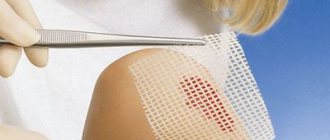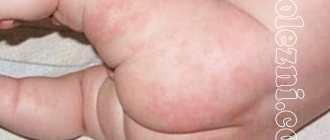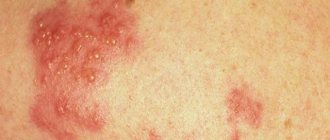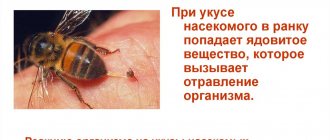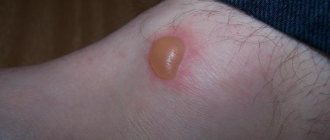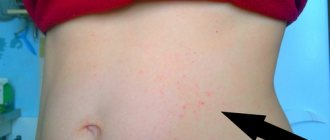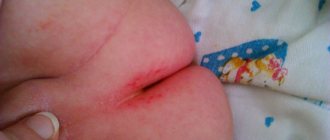Improper care
The skin on children's legs is extremely sensitive to negative influences. Dryness and flaking are often provoked by simply washing your feet with running water. For example, when the water is hard or contains a lot of chlorine. Therefore, after bathing procedures, be sure to apply a moisturizing, nourishing cream or baby oil to your feet. If possible, buy a special filter nozzle for the shower that will retain chlorine and mechanical impurities. This will prevent irritation and protect the baby’s skin from drying out. Prolonged bathing in hot water is also bad.
If the skin of a child's feet is peeling, the reason may be tight, artificial shoes, synthetic tights, or socks. When in contact with such materials, the skin “does not breathe” and sweats, which leads to peeling. The area between the toes is most affected.
Dry air has a negative effect on delicate baby skin. Many mothers notice that it is in winter, when there are hot radiators in the apartment, that the child’s palms and feet become very flaky.
You can solve the problem if:
- use moisturizer daily;
- regularly ventilate the apartment or house;
- maintain humidity within 40 - 60% using a humidifier or improvised means (wet towels, radiator sheets).
For intensive hydration and restoration of children's skin, ointments with provitamin B5 - Bepanten, Dexpanthenol - help.
Causes of cracks
The causes of cracked toes in children are quite varied. This may be due to the influence of external factors or disruptions in the functioning of the child’s body. Most often, the appearance of cracks on the fingers is associated with:
- Wearing tight, uncomfortable shoes. Constant friction against the material can lead to damage to the skin. Shoes made from low-quality materials do not allow air to circulate fully, causing your feet to steam and sweat.
- Wearing synthetic underwear. Socks or tights made of synthetic materials cause friction, disrupt air circulation, and accumulate excess moisture. This is why the likelihood of damage increases.
- Violations of hygiene standards. Failure to comply with water procedures leads to the accumulation of dirt on the surface of the skin, which subsequently becomes a breeding ground for pathogenic bacteria.
- Suffered injuries. Children's skin often cracks after limb fractures. The plaster in which the leg or arm is placed causes wounds and the dermis begins to dry out.
- Infectious diseases of the skin. Fungal infections and other infectious diseases lead to disruption of the integrity of the skin. In addition to cracks, weeping wounds, itching, burning, and delamination of the epithelium may be observed.
- Vitamin deficiency. A lack of vitamins A, B, E leads to the fact that the skin begins to burst, hair falls out, and teeth are affected.
- Allergic reactions. A child's reaction to allergens can manifest itself in a variety of symptoms, including cracking of the dermis.
- Psoriasis. A hereditary skin disease often manifests itself in childhood with the appearance of spots and plaques throughout the body. New growths peel and crack. The disease is not contagious and is genetic in nature.
If there are cracks on the toes and in the interdigital space in a child, especially at a young age, parents should contact a pediatrician or dermatologist to identify the true cause of this phenomenon. In some cases, cracks in the thumbs or little fingers are the first symptom of a dangerous pathological disorder that requires timely treatment.
Allergy
Peeling of the skin on a child’s feet is possible due to allergic reactions, atopic or contact dermatitis.
Irritation is caused by:
- washing powder that you use to wash children's socks or tights;
- baby creams, care oils;
- clothing made from synthetic fabrics;
- highly allergenic foods (citrus fruits, milk, chocolate, eggs, fish);
- insect bites;
- medicines, sweet syrups containing chemical flavors, dyes, flavoring additives.
Allergic reactions are often accompanied by severe itching. Parents should ensure that the child does not scratch the skin, otherwise an infection will occur. Antihistamines help cope with itching, redness, and inflammation. For effective treatment, it is important to identify and eliminate the allergen.
Why does dry skin form on a child's feet?
The skin on the feet of infants is considered to be the most sensitive up to 3 years of age. An additional risk factor is the autumn-winter period, when the wind outside becomes cold and the ambient temperature drops significantly.
The following circumstances may also cause peeling of the skin:
- Improper care of the baby to protect it from ultraviolet rays.
- Using low quality personal hygiene products.
- Bathing a baby in water above 38˚C.
- Temperature changes.
- Keeping the child in a room with low humidity air.
- Eating disorder.
- Insufficient intake of water into the body.
- Diseases.
Special means are used to protect the baby from the sun's rays, but a careful approach is important here.
An incorrectly selected cream will tighten the skin and cause peeling. The first places to be exposed to friction will be the legs. The best hygiene products are those that are colorless, odorless and have hypoallergenic properties. A poor-quality set of ingredients in the composition will lead not only to roughness of the baby’s feet, but also to rashes or itching.
Low humidity air in the room causes damage to tissues. It becomes this way at high ambient temperatures outside and during the heating season.
Proper nutrition of the baby plays a special role. It gives baby's skin elasticity, firmness and a healthy appearance. A deficiency of vitamins and other components makes it dry and flabby. Often the baby’s body experiences a high need for foods rich in nutrients in the spring.
The sun is extremely necessary for a baby, especially in the first years of life. With it, he receives vitamin D. The most favorable time for walking is 9-10 o'clock in the morning and 7-8 o'clock in the evening.
Ichthyosis
Some diseases manifest themselves as dryness on the legs. ARVI, skin diseases (psoriasis, eczema, ichthyosis), hypothyroidism, lichen, diabetes mellitus and infections are among them. The surface becomes rough and rough when the body does not receive enough fluid to maintain tissue tone.
This is especially true for the legs, which are a distant part of the body. When there is a shortage of water, the body has to spend the incoming fluid on basic functions to maintain life.
Fungal infection
If your child likes to try on other people's shoes, walks barefoot in public places or goes to the pool, there is a risk that he has contracted a fungus.
In addition to peeling, this infection is characterized by the following changes in the affected area:
- itching;
- redness, inflammation;
- unpleasant odor;
- thickening of the skin;
- formation of microcracks.
It often happens that peeling is the only symptom. Parents may not suspect that it is a fungus. The skin between the toes usually suffers first, and then, if left untreated, the infection progresses.
To combat the fungus, antifungal agents are used, which are recommended by a dermatologist, mycologist or podologist. The sooner treatment is started, the easier and faster it is to get rid of the infection.
Features of treatment
If a child develops dry skin on his toes, you should consult a doctor who will prescribe appropriate tests to determine the exact causes of the problem. Only after this can you begin therapy that will help eliminate all skin defects.
Drug treatment
You can treat peeling and cracks in the skin of the feet of babies with the following medications:
- Multivitamins (Multitabs, Pikovit, Centrum). Prescribed for vitamin deficiency and other diseases, which helps normalize the functioning of the whole body.
- Antihistamines (Fenistil, Fenkarol, Suprastin). Used if cracks in the fingers are caused by allergic reactions of various origins.
- Antiparasitic agents (Vermox, Helmintox). They are used to identify parasites in a child’s body. Use strictly as prescribed by a doctor, according to the instructions.
- Antifungal ointments (Clotrimazole, Lamikon). Used to detect a fungal infection. Usually they should be used over a long period of time to avoid relapse of the disease.
- Wound healing ointments (Bepanten, Actovegin). Stimulate tissue regeneration, which promotes the healing of cracks and renewal of the skin.
Alternative medicine
What to do if the skin on your child’s legs peels off
If your child has cracked and peeling skin on his legs, you can use one of the following folk remedies:
- Water is mixed in equal proportions with apple cider vinegar, and the feet are treated with this liquid. After the procedure, the legs are wrapped in gauze and left like that overnight. In the morning, feet should be rinsed well with water and lubricated with moisturizer.
- A tablespoon of chamomile and string is poured into 450 ml of boiling water and left for 20 minutes. The resulting medicine is poured into a bath of warm water. You need to bathe the baby in it (about 10 minutes). If the child is older, it is recommended to use a foot bath only.
- Finely chop one large onion, pour a glass of unrefined sunflower oil over it. The mixture is poured into a frying pan and kept on fire until the onion is browned. Additionally add three tablespoons of melted beeswax. The resulting mixture should be stored in the refrigerator and used to treat feet every day before bed.
Lack of vitamins
A deficiency of vitamins A, E and D leads to flaky feet in a child. Children under 5 years of age experience this more often than older children.
To tidy up your skin, adjust your baby's nutrition. Add freshly squeezed carrot, apple juice, nuts, vegetable oils, dairy products. If the skin on the feet and legs of an infant is peeling, the nursing mother should reconsider her diet. For bottle-fed babies, the pediatrician decides in what form it is best to add the missing vitamins. Vitamin complexes from a pharmacy are safe to give only as prescribed by a doctor.
If you have hypovitaminosis, you can try applying vitamins topically, directly to problem areas. To do this, take Aevit capsules, add their contents to a small amount of baby cream, and lubricate your feet after bathing. From pharmaceutical products, dermatologists prescribe Radevit ointment, which contains vitamins A, D, E.
Preventive measures
Why does a baby spit up curd - what to do?
It is easier to prevent a situation where a baby develops scabs on its legs than to treat them later. Therefore, parents need to take the following preventive actions seriously:
- Wash your baby’s feet every day before bed; when he grows up, teach him to do it on his own.
- After water procedures, lubricate the baby’s feet with baby cream with a moisturizing effect.
- Once every two days, give your baby warm foot baths, adding a decoction or infusion of medicinal herbs to the water. The baby should keep his feet in the water for at least 20 minutes.
- Treat softened and steamed feet with a special foot brush, removing the lagging layer of skin.
- Choose the right shoes. It should be made from natural materials. Do not buy very small and narrow boots or shoes.
- Wear the baby with socks and tights made from natural material that will provide the necessary ventilation of the feet. Wool or cotton works great.
- Maintain water balance. Make sure your baby drinks as much water as possible, especially in hot weather.
- Provide the baby with proper nutrition. The reason that a child's feet are very flaky may be a poor diet. Parents should ensure that all the food the baby eats is rich in vitamins and minerals.
- In autumn and spring, strengthen the child’s immunity with the help of various vitamin supplements.
- Use cosmetics and chemicals in general moderately when treating children's skin.
- Regularly hardening your baby will help strengthen the body’s protective properties.
Skin is very important for a person, especially a baby, since it is the most important protection from the environment. For this reason, it is necessary to carefully monitor the health of the skin. If the skin on your child's feet peels, you need to take appropriate measures immediately. After all, the sooner treatment begins, the sooner the baby’s heels and toes will become smooth and soft again.
Intestinal disorders
The cause of peeling skin on a child's feet is often associated with dysbacteriosis and helminthic infestation. Dysbacteriosis makes it difficult to digest food, and the absorption of vitamins and other substances beneficial to the skin deteriorates. Violation of the intestinal microflora often occurs in infants whose digestive system is not yet fully developed, and in children who have taken antibacterial agents. Probiotics and prebiotics help restore the balance of beneficial and harmful bacteria.
If your feet have been peeling for a long time, it won’t hurt to get tested for helminths. Damage to the body by these parasites negatively affects the condition of the skin, provokes dysbacteriosis, allergies, decreased immunity, and other disorders.
Skin diseases
Skin problems on the legs can be the result of dermatological diseases or infections.
These include:
- Eczema. A hereditary chronic disease, the development of which is provoked by allergies, reduced immunity, stress, and infections. With eczema on the feet, the skin becomes very dry, itchy, red, and covered in a rash;
- Psoriasis. Chronic non-contagious disease with genetic predisposition. The impetus for the appearance of symptoms can be a change of season, rubbing the skin with clothing, infections, or certain medications. Psoriasis causes scaly, inflamed red patches;
- Lichen. An infectious disease caused by various fungal or viral pathogens. There are 5 types of lichen. Ringworm (microsporia) is usually found in children. Children of preschool age and primary schoolchildren who come into contact with street cats or dogs get sick more often. This type of lichen appears as pink spots with a flaky center.
What to do?
Have you noticed that your child's feet are flaky? Don't rush to the moms' forum for advice. If the condition does not improve after using moisturizing baby cream, consult a doctor. Parents' independent conclusions about the cause of skin changes are often erroneous. And lost time and improper treatment only worsen the situation, leading to cracks and infection. Therefore, be sure to consult a dermatologist.
To prevent peeling, make sure your child has:
- complete balanced nutrition;
- moisturizing foot cream with natural composition;
- strong immunity;
- proper foot hygiene;
- comfortable, natural shoes.
To monitor the condition and prevent foot diseases, we recommend that you and your child undergo periodic examinations by a podiatrist and undergo medical pedicures.
child podology
Diagnosis of peeling skin on the feet of children
Diagnosis of peeling skin on the feet of children
The first symptoms that you should pay attention to and, if detected, consult a doctor:
- Peeling on the feet
- Redness of areas of the skin
- The appearance of an unpleasant odor
- Change in color of the nail plate, brittle nails
- Itching occurs
The specialist must prescribe tests, conduct an initial diagnosis of peeling skin on the feet of children, and identify the cause:
- If the cause of the disease is a fungal infection, the doctor prescribes tablet therapy together with creams that have antifungal effects. In addition, a course of multivitamins is prescribed.
- The child also undergoes tests that show the amount of sugar in the blood . This procedure is prescribed to children whose skin peels off on the palms and heels at the same time. If high sugar levels are detected, additional examinations aimed at identifying diabetes are prescribed.
- If an allergic reaction is detected , a series of tests are carried out to identify the allergen in order to further eliminate its effect on the child’s body. The attending physician also prescribes a regimen of medications and ointments that relieve allergy symptoms.
It is important to understand: If any symptoms of the disease appear, you must immediately consult a doctor. If this is not done, the disease will progress to an advanced form, and in the future a longer therapeutic path to full recovery will be required.

